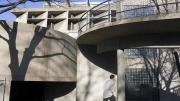Le Corbusier’s only building in North America, the Carpenter Center for the Visual Arts (CCVA), opened in 1963. It remains extraordinary, and Wiley professor of design Mohsen Mostafavi, dean of the Graduate School of Design (GSD), determined that the celebrated structure’s fiftieth birthday would not go unheralded by his faculty. (The Carpenter Center itself, home of the department of visual and environmental studies, is in the midst of a yearlong celebration, with multiple events.) Consequently, an exhibit on the CCVA in the Design School’s Loeb Library in Gund Hall, running until May 17, displays documents and renderings locked in the Harvard Archives for the past five decades. Included are eight large drawings, signed by the architect and never before seen by the public, that lay out his design for the five floors of the CCVA with refreshing elegance and simplicity.
The exhibition also includes a copy of the 1956 Report of the Committee on the Visual Arts at Harvard, the study by faculty members inside and outside the University that led to the construction of the center. There is also correspondence between Corbusier, based in Paris, and Josep Lluis Sert, then dean of the GSD, who was instrumental in bringing the building to Cambridge. A draft of a 1958 letter from Harvard specifies a maximum construction cost of $1.2 million, and there is even a 1960 letter from Sert to French president Charles de Gaulle defending Corbusier’s architecture against critics. A documentary film on the CCVA by Bruce Seth Green runs continuously on a screen mounted on a wall of the library.
One letter on display, to Sert, includes Corbusier’s reactions to some of the working plans drawn up by American architects to realize his design. “Je refuse absolument les ‘cement blocs’ a l’interior du bâtiment: c’est horrible!’” (“I absolutely reject cinder blocks for the building’s interior: they are horrible!”) it reads, at one point. At another place he objects to the inclusion of aerateurs (ventilators), remarking that “le bâtiment n’est pas une automobile.”
For the exhibition’s opening on April 4, the GSD invited the Carpenter Center’s first director, Eduard Sekler, Hooker professor of visual art emeritus and professor of architecture emeritus, to Gund Hall to give a talk on the building’s origins. Mostafavi introduced the architectural historian and preservationist, outlining his career from its Viennese roots to years in London, to his arrival at Harvard when Walter Gropius was an architecture professor, and to his appointment as a full professor himself in 1960.
Sekler began by acknowledging former president Nathan Pusey, who signed off on the Carpenter Center project, as “a real reformer who wanted to have the future come into the University.” The 1956 report, he said, had recommended the creation of a new department of design within the Faculty of Arts and Sciences, and the construction of a new design center to house it and the GSD at a location near the Fogg Art Museum and Robinson Hall, then the GSD’s home. He projected a drawing in the report that shows a hypothetical L-shaped structure hard by the Fogg, with a theater nestled between it and the Faculty Club.
That was before the appearance of Corbusier and his startling edifice, which was “not necessarily welcomed by everybody,” Sekler recalled. “More traditional professors thought it was a disgrace.” Sekler chose instead to celebrate the architect (who died in 1965) with an exhibition of his work. In his talk, he showed a slide of English professor I.A. Richards teaching in the CCVA in the early days, and shared some examples of exhibitions staged in its flexible inner terrain, among them “The Shape of Sound: Form in Musical Instruments,” “Proportion, a Measure of Order,” “Approaches to Color,” “Search for Total Construction: USSR 1917-1932,” and “Anonymous Art from Market and Bazaar.”
A few audience members who had studied in the CCVA in the early years rose to share recollections; Howard Elkus, M.Arch. ’63, declared that Le Corbusier “saw how Harvard worked—the paths of Harvard—and made them three-dimensional. A lot of Harvard buildings were ‘sealed up’ at that time. But the Carpenter Center—you don’t have to go inside this building to know what’s going on.”








